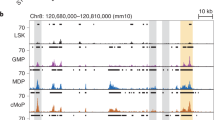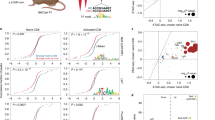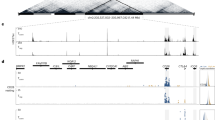Abstract
Major histocompatibility class II (MHC-II) expression is critical for immune responses and is controlled by the MHC-II transactivator CIITA. CIITA is primarily regulated at the transcriptional level and is expressed from three main promoters with myeloid, lymphoid and interferon (IFN)-γ-treated non-hematopoietic cells using promoters pI, pIII and pIV, respectively. Recent studies in non-hematopoietic cells suggest that a series of distal regulatory elements may be involved in regulating CIITA transcription. To identify distal elements in B cells, a DNase I hypersensitivity screen was performed, revealing a series of potential novel regulatory elements. These elements were analyzed computationally and biochemically. Several regions displayed active histone modifications and/or enhanced expression of a reporter gene. Four of the elements interacted with pIII in B cells. These same four regions were also found to interact with pI in splenic dendritic cells (spDC). Intriguingly, examination of the above interactions in pI-knockout-derived spDC showed a switch to the next available promoter, pIII. Extensive DNA methylation was found at the pI region in B cells, suggesting that this promoter is not accessible in B cells. Thus, CIITA expression is likely mediated in hematopoietic cells by common elements with promoter accessibility having a part in promoter choice.
This is a preview of subscription content, access via your institution
Access options
Subscribe to this journal
Receive 6 digital issues and online access to articles
$119.00 per year
only $19.83 per issue
Buy this article
- Purchase on Springer Link
- Instant access to full article PDF
Prices may be subject to local taxes which are calculated during checkout









Similar content being viewed by others

References
Collins T, Kormana J, Wake CT, Boss JM, Kappes DJ, Fiers W et al. Immune interferon activates multiple class II major histocompatibility complex genes and the associated invariant chain gene in human endothelial cells and dermal fibroblasts. Proc Natl Acad Sci USA 1984; 81: 4917–4921.
Steimle V, Siegrist CA, Mottet A, Lisowska-Grospierre B, Mach B . Regulation of MHC class II expression by interferon-gamma mediated by the transactivator gene CIITA. Science (80-) 1994; 265: 106–109.
Pai RK, Askew D, Boom WH, Harding CV . Regulation of class II MHC expression in APCs: roles of types I, III, and IV class II transactivator. J Immunol 2002; 169: 1326–1333.
Benacerraf B . Role of MHC gene products in immune regulation. Science 1981; 212: 1229–1238.
Choi N, Majumder P, Boss J . Regulation of major histocompatibility complex class II genes. Curr Opin Immunol 2011; 23: 81–87.
Masternak K, Reith W . Promoter-specific functions of CIITA and the MHC class II enhanceosome in transcriptional activation. EMBO J 2002; 21: 1379–1388.
Silacci P, Mottet A, Steimle V, Reith W, Mach B . Developmental extinction of major histocompatibility complex class II gene expression in plasmocytes is mediated by silencing of the transactivator gene CIITA. J Exp Med 1994; 180: 1329–1336.
Muhlethaler-Mottet A, Otten LA, Steimle V, Mach B . Expression of MHC class II molecules in different cellular and functional compartments is controlled by differential usage of multiple promoters of the transactivator CIITA. EMBO J 1997; 16: 2851–2860.
Lennon A, Ottone C, Rigaud G, Deaven L . Isolation of a B-cell-specific promoter for the human class II transactivator. Immunogenetics 1997; 45: 266–273.
Chin KC, Mao C, Skinner C, Riley JL, Wright KL, Moreno CS et al. Molecular analysis of G1B and G3A IFN gamma mutants reveals that defects in CIITA or RFX result in defective class II MHC and Ii gene induction. Immunity 1994; 1: 687–697.
Rigaud G, Barbaro ADL, Nicolis M, Cestari T, Ramarli D, Riviera A-P et al. Induction of CIITA and modification of in vivo HLA-DR promoter occupancy in normal thymic epithelial cells treated with IFN-y. J Immunol 1996; 156: 4254–4258.
Zinzow-Kramer WM, Long AB, Youngblood BA, Rosenthal KM, Butler R, Mohammed AU et al. CIITA promoter I CARD-deficient mice express functional MHC class II genes in myeloid and lymphoid compartments. Genes Immun 2012; 13: 299–310.
Steimle V, Otten LA, Zufferey M, Mach B . Complementation cloning of an MHC class II transactivator mutated in hereditary MHC class II deficiency (or bare lymphocyte syndrome). Cell 1993; 75: 135–146.
Chang CH, Guerder S, Hong SC, van Ewijk W, Flavell RA . Mice lacking the MHC class II transactivator (CIITA) show tissue-specific impairment of MHC class II expression. Immunity 1996; 4: 167–178.
Ghosh N, Piskurich JF, Wright G, Hassani K, Ting JP, Wright KL . A novel element and a TEF-2-like element activate the major histocompatibility complex class II transactivator in B-lymphocytes. J Biol Chem 1999; 274: 32342–32350.
Green MR, Yoon H, Boss JM . Epigenetic regulation during B cell differentiation controls CIITA promoter accessibility. J Immunol 2006; 177: 3865–3873.
Holling TM, van der Stoep N, Quinten E, van den Elsen PJ . Activated human T cells accomplish MHC class II expression through T cell-specific occupation of class II transactivator promoter III. J Immunol 2002; 168: 763–770.
Ghosh N, Gyory I, Wright G, Wood J, Wright KL . Positive regulatory domain I binding factor 1 silences class II transactivator expression in multiple myeloma cells. J Biol Chem 2001; 276: 15264–15268.
Piskurich JF, Lin KI, Lin Y, Wang Y, Ting JP, Calame K . BLIMP-I mediates extinction of major histocompatibility class II transactivator expression in plasma cells. Nat Immunol 2000; 1: 526–532.
Yoon HS, Scharer CD, Majumder P, Davis CW, Butler R, Zinzow-Kramer W et al. ZBTB32 is an early repressor of the CIITA and MHC class II gene expression during B cell differentiation to plasma cells. J Immunol 2012; 189: 2393–2403.
Van der Stoep N, Quinten E, Marcondes Rezende M, van den Elsen PJ . E47, IRF-4, and PU.1 synergize to induce B-cell-specific activation of the class II transactivator promoter III (CIITA-PIII). Blood 2004; 104: 2849–2857.
Yoon H, Boss JM . PU.1 binds to a distal regulatory element that is necessary for B cell-specific expression of CIITA. J Immunol 2010; 184: 5018–5028.
Ni Z, Abou El Hassan M, Xu Z, Yu T, Bremner R . The chromatin-remodeling enzyme BRG1 coordinates CIITA induction through many interdependent distal enhancers. Nat Immunol 2008; 9: 785–793.
Naumova N, Smith EM, Zhan Y, Dekker J . Analysis of long-range chromatin interactions using Chromosome Conformation Capture. Methods 2012; 58: 192–203.
Tolhuis B, Palstra RJ, Splinter E, Grosveld F, de Laat W . Looping and interaction between hypersensitive sites in the active beta-globin locus. Mol Cell 2002; 10: 1453–1465.
Majumder P, Gomez J a, Chadwick BP, Boss JM . The insulator factor CTCF controls MHC class II gene expression and is required for the formation of long-distance chromatin interactions. J Exp Med 2008; 205: 785–798.
Heinz S, Benner C, Spann N, Bertolino E, Lin YC, Laslo P et al. Simple combinations of lineage-determining transcription factors prime cis-regulatory elements required for macrophage and B cell identities. Mol Cell 2010; 38: 576–589.
Bell a C, West a G, Felsenfeld G . The protein CTCF is required for the enhancer blocking activity of vertebrate insulators. Cell 1999; 98: 387–396.
Majumder P, Scharer CD, Choi NM, Boss JM . B cell differentiation is associated with reprogramming the CCCTC binding factor-dependent chromatin architecture of the murine MHC class II locus. J Immunol 2014; 192: 3925–3935.
Heintzman ND, Stuart RK, Hon G, Fu Y, Ching CW, Hawkins RD et al. Distinct and predictive chromatin signatures of transcriptional promoters and enhancers in the human genome. Nat Genet 2007; 39: 311–318.
Creyghton MP, Cheng AW, Welstead GG, Kooistra T, Carey BW, Steine EJ et al. Histone H3K27ac separates active from poised enhancers and predicts developmental state. Proc Natl Acad Sci USA 2010; 107: 21931–21936.
Karmodiya K, Krebs AR, Oulad-Abdelghani M, Kimura H, Tora L . H3K9 and H3K14 acetylation co-occur at many gene regulatory elements, while H3K14ac marks a subset of inactive inducible promoters in mouse embryonic stem cells. BMC Genomics 2012; 13: 424.
Revilla-I-Domingo R, Bilic I, Vilagos B, Tagoh H, Ebert A, Tamir IM et al. The B-cell identity factor Pax5 regulates distinct transcriptional programmes in early and late B lymphopoiesis. EMBO J 2012; 31: 3130–3146.
Bernstein BE, Birney E, Dunham I, Green ED, Gunter C, Snyder M . The ENCODE Project Consortium. An integrated encyclopedia of DNA elements in the human genome. Nature 2012; 489: 57–74.
Scharer C, Barwick B, Youngblood B, Ahmed R, Boss J . Global DNA methylation remodeling accompanies CD8 T cell effector function. J Immunol 2013; 191: 3419–3429.
Ochiai K, Maienschein-Cline M, Simonetti G, Chen J, Rosenthal R, Brink R et al. Transcriptional regulation of germinal center B and plasma cell fates by dynamical control of IRF4. Immunity 2013; 38: 918–929.
Cheung M-S, Down T a, Latorre I, Ahringer J . Systematic bias in high-throughput sequencing data and its correction by BEADS. Nucleic Acids Res 2011; 39: e103.
Benjamini Y, Speed TP . Summarizing and correcting the GC content bias in high-throughput sequencing. Nucleic Acids Res 2012; 40: e72.
Gheldof N, Smith EM, Tabuchi TM, Koch CM, Dunham I, Stamatoyannopoulos Ja et al. Cell-type-specific long-range looping interactions identify distant regulatory elements of the CFTR gene. Nucleic Acids Res 2010; 38: 4325–4336.
Kulaeva OI, Nizovtseva EV, Polikanov YS, Ulianov SV, Studitsky VM . Distant activation of transcription: mechanisms of enhancer action. Mol Cell Biol 2012; 32: 4892–4897.
Austin JW, Lu P, Majumder P, Ahmed R, Boss JM . STAT3STAT4, NFATc1, and CTCF regulate PD-1 through multiple novel regulatory regions in murine T cells. J Immunol 2014; 192: 4876–4886.
Teferedegne B, Green MR, Guo Z, Boss JM . Mechanism of action of a distal NF-kappaB-dependent enhancer. Mol Cell Biol 2006; 26: 5759–5770.
Chen P, Zhao J, Wang Y, Wang M . H3.3 actively marks enhancers and primes gene transcription via opening higher-ordered chromatin. Genes 2013; 27: 2109–2124.
Zhu Y, Sun L, Chen Z, Whitaker JW, Wang T, Wang W . Predicting enhancer transcription and activity from chromatin modifications. Nucleic Acids Res 2013; 41: 10032–10043.
Zentner GE, Tesar PJ, Scacheri PC . Epigenetic signatures distinguish multiple classes of enhancers with distinct cellular functions. Genome Res 2011; 21: 1273–1283.
Pekowska A, Benoukraf T, Zacarias-Cabeza J, Belhocine M, Koch F, Holota H et al. H3K4 tri-methylation provides an epigenetic signature of active enhancers. EMBO J 2011; 30: 4198–4210.
Smith Ma, Wright G, Wu J, Tailor P, Ozato K, Chen X et al. Positive regulatory domain I (PRDM1) and IRF8/PU.1 counter-regulate MHC class II transactivator (CIITA) expression during dendritic cell maturation. J Biol Chem 2011; 286: 7893–7904.
Dziembowska M, Fondaneche MC, Vedrenne J, Barbieri G, Wiszniewski W, Picard C et al. Three novel mutations of the CIITA gene in MHC class II-deficient patients with a severe immunodeficiency. Immunogenetics 2002; 53: 821–829.
Oestreich KJ, Yoon H, Ahmed R, Boss JM . NFATc1 regulates PD-1 expression upon T cell activation. J Immunol 2008; 181: 4832–4839.
Beresford GW, Boss JM . CIITA coordinates multiple histone acetylation modifications at the HLA-DRA promoter. Nat Immunol 2001; 2: 652–657.
Miller W, Rosenbloom K, Hardison RC, Hou M, Taylor J, Raney B et al. 28-way vertebrate alignment and conservation track in the UCSC Genome Browser. Genome Res 2007; 17: 1797–1808.
Acknowledgements
We thank the members of the Boss lab for their helpful critiques and suggestions. This work was supported by the National Institutes of Health grants RO1GM47310 and T32GM0008490.
Author information
Authors and Affiliations
Corresponding author
Ethics declarations
Competing interests
The authors declare no conflict of interest.
Additional information
Supplementary Information accompanies this paper on Genes and Immunity website
Rights and permissions
About this article
Cite this article
Lohsen, S., Majumder, P., Scharer, C. et al. Common distal elements orchestrate CIITA isoform-specific expression in multiple cell types. Genes Immun 15, 543–555 (2014). https://doi.org/10.1038/gene.2014.49
Received:
Revised:
Accepted:
Published:
Issue Date:
DOI: https://doi.org/10.1038/gene.2014.49
This article is cited by
-
Plasma cell differentiation is controlled by multiple cell division-coupled epigenetic programs
Nature Communications (2018)
-
Development of potent class II transactivator gene delivery systems capable of inducing de novo MHC II expression in human cells, in vitro and ex vivo
Gene Therapy (2017)
-
Critical Role of Transcription Factor PU.1 in the Function of the OX40L/TNFSF4 Promoter in Dendritic Cells
Scientific Reports (2016)


